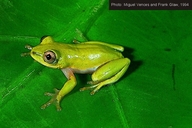|
Description
A medium-sized Heterixalus; males 22-25 mm, females 27-29 mm. The colour of the back is uniformly greenish, in males more yellowish. Dorsilateral bands are not present in adults, but juveniles have light bands. Thighs, ventral surface of limbs, hands and feet are orange. Venter creamish.
Similar species: The call of H. boettgeri is similar to the call of H. madagascariensis, but both species differ by colouration. H. betsileo from the highlands (Manjakatompo) can be uniformly greenish. The pupil shape of green coloured Boophis is horizontal.
Distribution and Habitat
Country distribution from AmphibiaWeb's database: Madagascar
Andohahela (Col Tanatana), Cap Sainte Marie, Isaka-Ivondro (TL), Malahelo, Manantantely, Mandena, Nahampoana, Petriky, Sainte Luce, Tolagnaro. It occurs below 300m asl. It lives in dry forest areas, rainforest edges, littoral forest on sand (i.e., habitat immediately behind sand dunes) deforested areas, croplands and villages and urban areas (Nussbaum and Raxworthy 2008).
Life History, Abundance, Activity, and Special Behaviors
Habits: During the day, found on sun-exposed broad leaves, with the head directed downwards or upwards. After rainfall, males call during the night, in sun-exposed swamps and rice-fields, together with Boophis tephraeomystax, B. opisthodon, Scaphiophryne calcarata, Ptychadena mascareniensis, and Tomopterna labrosa.
Call (from Tolagnaro): The call consists of two unharmonius note types. The first type lasts upto 2000 ms. The second type is shorter (35-55 ms) and arranged in long series of about 30 notes, with an interval between notes of 35-55 ms and a note repetition rate of about 10/s. These series are often preceeded by a shorter note of type 1 (duration ca. 600 ms). The frequency ranges from 2 to 3.7 kHz.
Eggs and tadpoles (from Tolagnaro, figs. 194-195): Tadpoles in stages 28-40 were found during March in slow-running water, together with fish. A tadpole in stage 28 had a body length of 8 mm and a total length of 23 mm; a tadpole in stage 40 had a body length of 12 mm and a total length of 37 mm. Tooth formula of 8 tadpoles was 1//1+1/2. In captivity, one female specimen, which metamorphosed in March, was sexually mature after about 4 months, with many eggs clearly recognizable through the ventral skin. At that age, it measured 25 mm and the back was already green.
Trends and Threats
It occurs in Cap St Marie Special Reserve and Mandena Classified Forest, and possibly in Parc National d'Andohahela (Nussbaum and Raxworthy 2008).
Comments
Taken with permission from Glaw and Vences (2007).
References
Glaw, F. and Vences, M. (1994). Amphibians and Reptiles of Madagascar. M. Vences and F. Glaw Verlags GbR., Köln.
Glaw, F., and Vences, M. (2007). Field Guide to the Amphibians and Reptiles of Madagascar. Third Edition. Vences and Glaw Verlag, Köln.
Nussbaum, R. and Raxworthy, C. (2008). Heterixalus boettgeri. In: IUCN 2008. 2008 IUCN Red List of Threatened Species. www.iucnredlist.org. Downloaded on 01 April 2009.
Originally submitted by: Miguel Vences and Frank Glaw (first posted 2000-11-03)
Edited by: Henry Zhu (2010-07-18)Species Account Citation: AmphibiaWeb 2010 Heterixalus boettgeri <https://amphibiaweb.org/species/489> University of California, Berkeley, CA, USA. Accessed Jan 21, 2025.
Feedback or comments about this page.
Citation: AmphibiaWeb. 2025. <https://amphibiaweb.org> University of California, Berkeley, CA, USA. Accessed 21 Jan 2025.
AmphibiaWeb's policy on data use.
|
